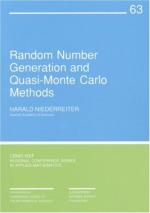|
This section contains 566 words (approx. 2 pages at 300 words per page) |

|
Roll a die and write down the number on the top face. This will be a random number because it was generated by a random process whose outcome could not be predicted in advance. Mathematicians, scientists, and even gamblers often want to simulate chance occurrences. Rather than roll dice, toss coins, or pick balls from urns--methods that were common 100 years ago--today they often use random numbers drawn from a table or generated by a computer. Random numbers are used in casino games, state lotteries, computer games, clinical trials of new drugs, simulations of random walks, encryption techniques, modeling molecular behavior, testing computer programs, and even in computer graphics for rendering realistic-looking images. Monte Carlo simulations refer to algorithms that use random numbers and statistical sampling to estimate calculations in physics, probability theory, and other areas of mathematics and science.
In 1927, L. Tippitt of the Biometric Laboratory...
|
This section contains 566 words (approx. 2 pages at 300 words per page) |

|


